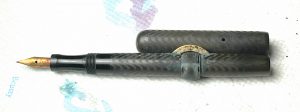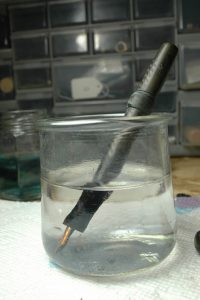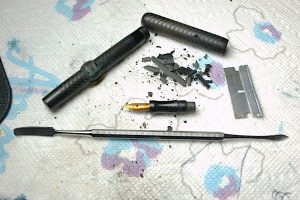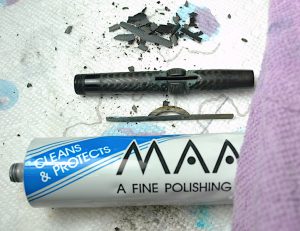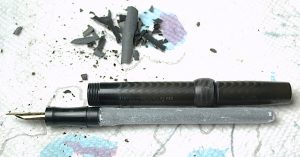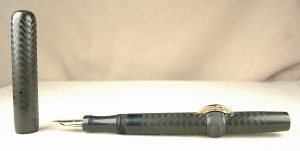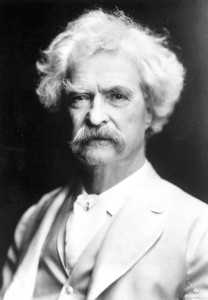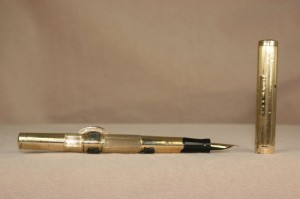When I first started ThePenMarket.com, I also worked part-time at a brick-and-mortar pen shop in a mall. I was far more familiar with vintage pens than modern, and I was very excited to see that the Conklin Pen Company had been brought back to life at around the same time.
I had no idea who was behind the new Conklin, but I was thrilled to see the return of newer and bigger Crescent pens that were much more comfortable to hold and use than the often tiny originals.
Lo and behold, roughly 20 years later, a Facebook post brought me in contact with not only the genius behind the resurrection of Conklin, BUT also Esterbrook, LeBoeuf and the ubiquitous pen of office workers everywhere in the 1990s—Sensa! He also was a founding member of the major American pen distributor called Kenro Industries in 1993!
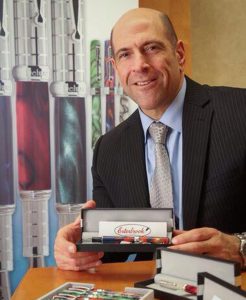
Robert Rosenberg is the inspired entrepreneur who has resurrected the vintage pen brands of Conklin, Esterbrook, LeBoeuf and the modern brand Sensa!
His name is Robert Rosenberg, and he has kindly agreed to talk with us here at ThePenMarket.com to tell us a little about his adventure in pens and his products moving forward.
ThePenMarket: Welcome to our Drippy Musings! It is an honor to be able to talk with you about your impressive successes bringing back beloved pen brands of yesteryear. Please tell us a little about how you got into pens.
Robert Rosenberg: My father was in pens. I grew up in the pen industry. When I was a little boy, my grandfather became the exclusive U.S. distributor of Pilot pens. My father joined him. At the time, Pilot had only one pen: the Razor Point. It became a great success. [Pilot eventually broke their distribution contract, and his dad worked out a deal where he remained a consultant and helped establish Pilot as a much larger company in the U.S. His father also was the first to help bring Sailor pens to the U.S. in the early 1980s]
My father was now in the pen industry, and he formed another company to distribute Waterman pens in the U.S. [At the time Waterman was an independently owned French company, not a part of Newell-Rubbermaid, as it is today.] After their initial success, Waterman then tried to set up its own company in the U.S. and Dad became the president of that subsidiary in the United States in 1986.
TPM: Did you have any interest in vintage pens brands when you were younger?
RR: My father and I used to go to flea markets as a kid. We’d go to flea markets to look for old Waterman pens. We bought a lot of them.
TPM: How did you come up with the idea to first bring back Conklin?
RR: I was very familiar with the pen business when I decided to go to law school. I took a course about trademarks. And it taught the law regarding what you do with abandoned trademarks. I wondered if there were any pen brands that fell off the face of the earth. I did the research, and I found Conklin.
TPM: How do you bring back a dead company? Do you have to pay someone for the rights to it? Who would you even pay?
RR: In trademark law, if there is brand that is no longer around any more and a certain amount of time has passed, you can file a trademark application with the U.S. Patent and Trademark office. It is a long process and it doesn’t always work. It isn’t easy, but I was able to acquire the rights to Conklin.
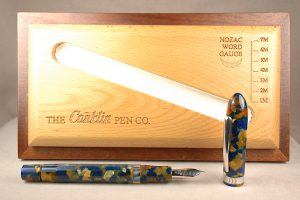
This modern Conklin Nozac was one of the very first pens Rosenberg released with help from Visconti.
TPM: I love how you redeveloped a successful Nozac filler and the Crescent filler. I, honestly, think that was the key Conklin’s incredible success. How did you manage to go retro when the world was locked into cartridge and converters?
RR: That was probably the smartest thing I did, and it was not totally my idea. I worked with Dante Del Vecchio at Visconti. He was very eager to work with me. We worked out a deal and he made it for us.
TPM: With Conklin seemingly really roaring along, why did you sell the company?
RR: I didn’t want to sell the company. My father had come on as a partner. And we ran it; we built it. Then one morning I found him at my desk. He had a brain hemorrhage and passed away. We sold it to YAFA due to estate issues that arose from my father’s passing.
TPM: In 2015, you breathed fresh life into Esterbrook. What inspired you to go back and revive that brand?
RR: I had been looking at that brand for a number of years. It was still trademarked by somebody, and I was keeping my eye on it for a long time. Eventually the trademark had been cancelled. I wasn’t even aware of how big the history of the company was. I think I made some missteps in the beginning. We had some backlash from the pen community. [The pen community wanted the return of its J-model pens from the early ’50s and the original replaceable screw-in Esterbrook nibs. But, as Mr. Rosenberg pointed out, even if Esterbrook had not gone out of business, they wouldn’t be still making pens just as they did 70 years ago.] We did have some nice pens. I had worked with Kenro for a year really getting Esterbrook running, again, and then I eventually sold it to them.
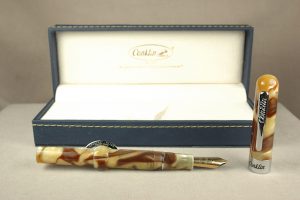
The Conklin Mark Twain was the first really big hit Rosenberg’s resurrection of Conklin had. It was based on the original pen from the late 19th century. The old company had paid the author Mark Twain to be its first spokesman.
TPM: Clearly, you weren’t done, yet, bringing back the iconic LeBoeuf in 2019. How did that come about. Unlike the other two brands, which had died out decades earlier, hadn’t there already been an attempt to bring back LeBoeuf in the 1980s or ’90s? I have one of their “Greg Norman” pens on my website.
RR: Yes. They did a horrible job. I remember when LeBoeuf was brought back. I shook my head at the time, and I didn’t understand what they were doing. They had nice boxes, but that was it.
At the time I also got Sensa. After the company’s roaring success in the 1990s, Newell-Rubbermaid had bought it for $25 million. The reason that they bought it was for the patents on the grips. It never worked out for them, and they just dropped it and let it go. It is crazy. They had a huge following. We still get calls from people to replace their grips. [The original Sensa Plasmium grips started decomposing, leaking and getting sticky.]
The grips are very tricky to make. We spent a lot of time to get the Plasmium grip just right so it won’t have those problems as before. However, we had to redesign the pen to make these new grips work better, which is why we can’t replace the grips on the old pens.
TPM: For readers who don’t know this, LeBoeuf was founded in 1919 in Springfield, Mass. It was the very first pen company to manufacture fountain pens made of celluloid. Robert, you’ve brought back some beautiful recreations of some of those early designs in modern acrylic pens. Are there plans to keep bringing back more of those stunning early designs?
RR: Yes. The thing with LeBoeuf is that they didn’t have a lot of different models. They had a brief history. They had this Pilgrim, and we are going to continue with that. We do have some other designs and productions. We’ve sort of made a name for ourselves with our limited editions. We just came out with a Winston Churchill this week, and we’ve almost already sold out of it. We’ve got new releases planned through 2025. People have really gotten into the limited editions and themes. Edgar Allen Poe was probably our best seller. Next month we have a Herman Melville. It is a nice business model.
TPM: Given how vintage filling systems really seemed to be key to the success of reviving Conklin, is there any hope for the classic sleeve fillers once used by LeBoeuf? In truth they were basically very simple aerometric fillers under the sleeve.
RR: We’re trying. We’re working on some designs now. We do have some other vintage inspired pens that we are working on. They will be out in 2024.
TPM: How about a solid-gold nib?
RR: We tend to have stayed away from the gold because of the pricing.
TPM: What can we pen devotees expect from you in the future?
RR: We are working on a new Sensa fountain pen. I think it will be more acceptable to fountain pen users.
TPM: Thank you so much for taking the time to talk with us today! Best of luck in all of your inky endeavors. To see more about modern LeBoeuf or Sensa, please go to their websites:


 Shopping Cart
Shopping Cart




